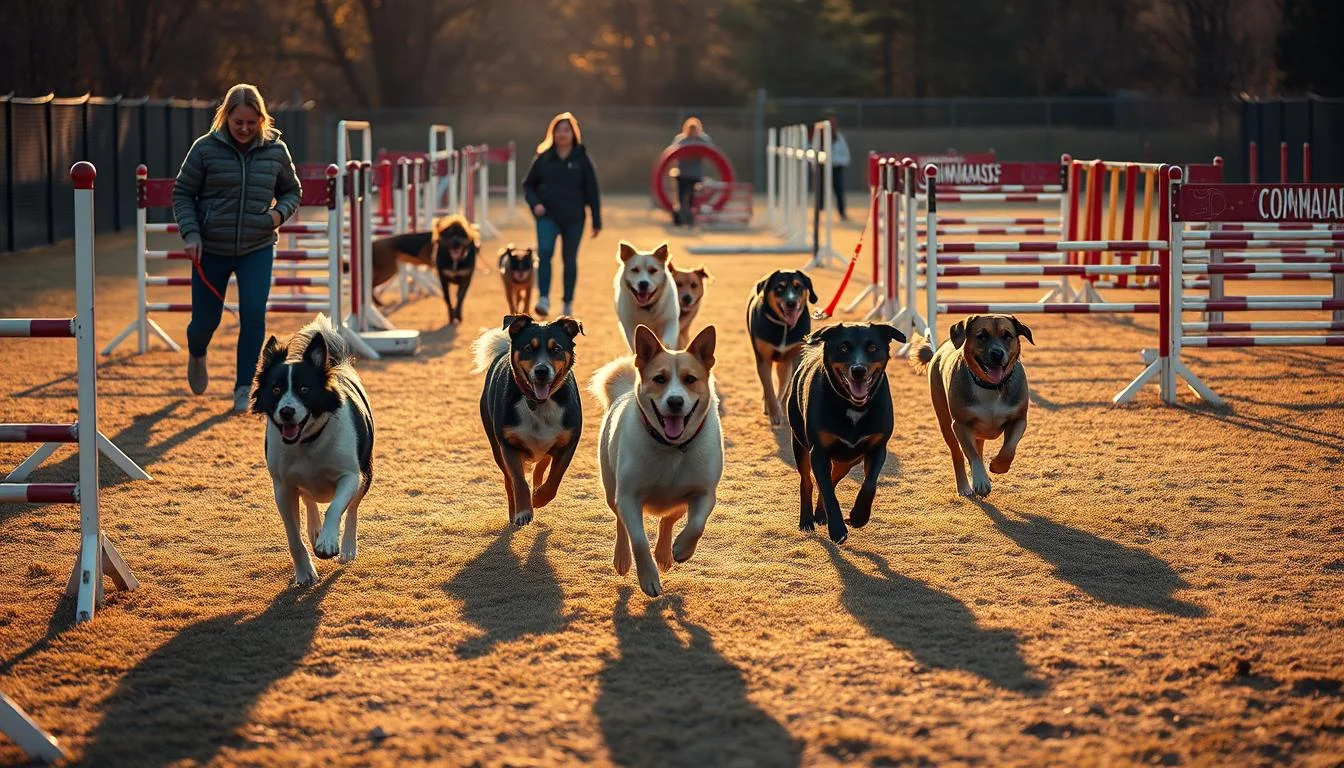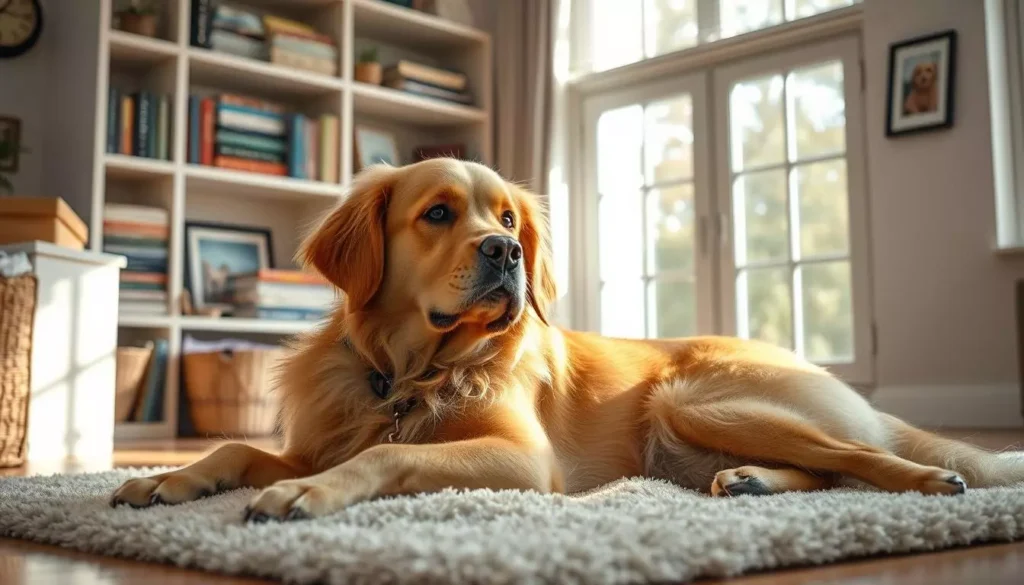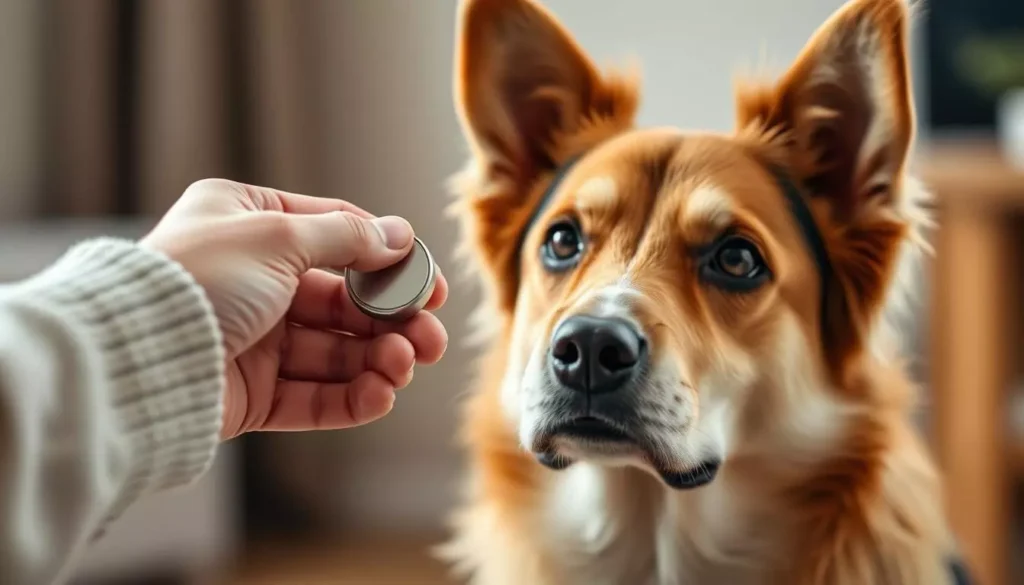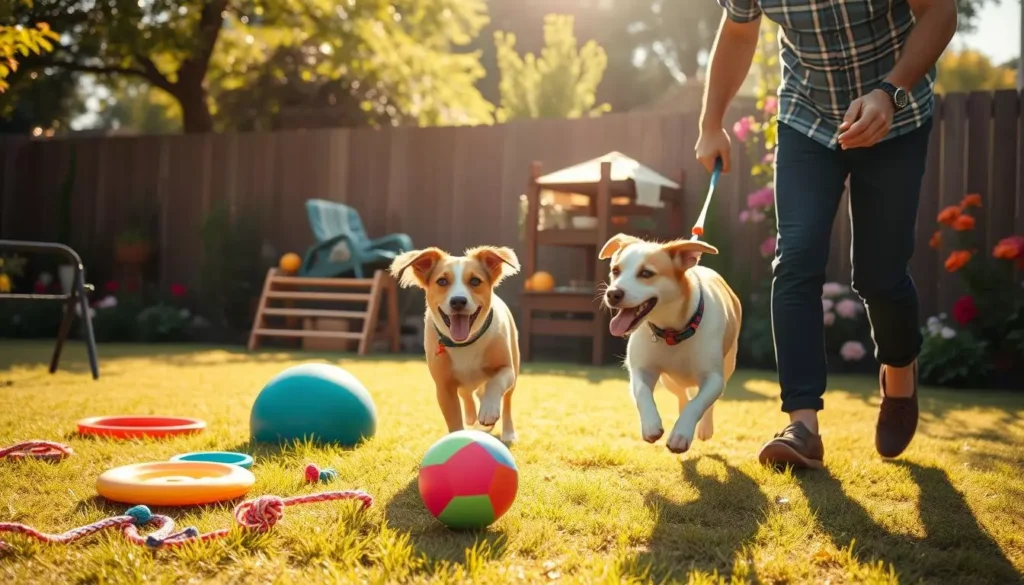I remember the first time my Labrador hesitated at a tunnel's edge. My heart skipped a beat, filled with hope. That moment, the wag of his tail and his leap, made me keep training.
Dog agility is a mix of athleticism and teamwork. Dogs run through tunnels, jump over hurdles, and weave through poles. I guide them with my voice, body, and timing. Success is about clear cues, trust, and rewards.
What amazed me was how dog agility welcomes all. From Border Collies to Chihuahuas, and from young to old, it's for everyone. AKC events and local classes make starting easy. But, always check with your vet first and build up slowly to avoid injuries.
Key Takeaways
- Dog agility training builds partnership through clear communication and positive reinforcement.
- Canine agility training includes core obstacles like tunnels, jumps, and weave poles.
- Agility training for dogs is accessible to many breeds, ages, and physical abilities.
- Short, fun sessions at home and local classes set beginners up for success.
- Always consult your veterinarian and progress gradually to prevent injury.
What Is Dog Agility and Why I Love the Sport
I fell in love with dog agility the first time I saw a team in action. It's a sport where handlers guide their dogs through a timed course with 14–20 obstacles. The course includes jumps, tunnels, weave poles, and more.
Handlers must stay off leash and can't touch their dogs. The key to success is timing, clear body language, and voice cues. This makes all the difference in a dog's performance.
Every run, the obstacle order changes, so learning to read the course is crucial. The obstacles have painted contact zones that dogs must hit on the way down. Jumps come in different sizes, and some handlers prefer lower heights for their dogs.
Practicing on real equipment builds speed and confidence. Safety is always the top priority.
Defining the sport and common obstacles
At its core, dog agility tests speed, accuracy, and teamwork. A course combines flatwork and obstacles into a flowing challenge. Weave poles require precision, tunnels reward boldness, and the dog walk and A-frame demand controlled contact.
Each obstacle asks for a different skill set from both dog and handler. This variety makes the sport exciting and challenging.
I introduce obstacles gradually to avoid overwhelming my dog. Short, focused sessions are key. I use toys and treats to mark success. This approach helps in backyard practice and when shopping for equipment.
Benefits for dogs and owners
Agility gives dogs a physical workout and a mental challenge. Arlene Spooner from the American Kennel Club notes it improves exercise, socialization, and purpose. Dogs become more confident and less anxious after regular training.
Owners get a mental challenge from reading courses and planning lines. Training builds trust and clearer communication. Clubs and classes create a community where I found friends who share tips and advice.
Regular training sessions are both exercise and bonding time for me and my dog.
| Aspect | What It Builds | Practical Tip |
|---|---|---|
| Jumps | Speed, timing, appropriate height selection | Start low, reward tight turns, adjust height for shoulder clearance |
| Weave Poles | Precision, repetitive pattern learning | Use channel or guide training, shorten sessions for focus |
| Tunnels | Boldness, straight-line speed | Use short runs and visible entry targets to build confidence |
| Contact Obstacles | Balance, controlled descent, contact-zone awareness | Paint zones, use progressive contact training on dog walk and A-frame |
| Home Practice | Consistency, handler cues, focus work | Invest in basic dog agility equipment and set short daily drills |
Is Agility Right for Your Dog
I think about a few things before signing up for agility classes. It's good for many dogs and their owners, but I check a few things first. I make sure the dog is healthy and the right age for it.
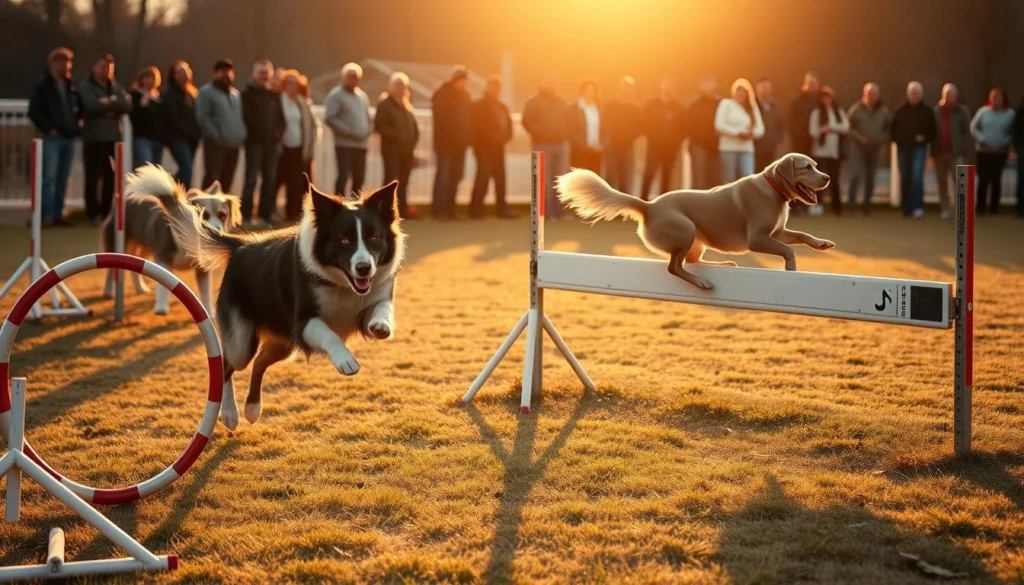
Any dog can do agility, no matter the breed. The obstacles are set up to fit different sizes. I look for dogs with strong joints and good movement.
For puppies, I keep the jumps low to protect their bones. This helps them grow strong without injury.
Age is another important factor. Young dogs usually pick up agility quickly. Older dogs can also compete if they stay healthy and pain-free.
I start them off slow to help their muscles get used to the activity. This also helps reduce the impact on their joints.
Personality plays a big role in how well a dog does in agility. Confident dogs learn fast in group classes. Dogs that are anxious or reactive might need more time, but agility training can help them become calmer and more focused.
Handlers are important too. Even if you can't move around much, you can still do agility. There are ways to handle the dog that don't require a lot of physical effort. Young handlers can also do well with the right guidance.
Basic obedience is key for safe agility training. I mix obedience drills with agility to help dogs learn faster and more reliably. This approach keeps the dog safe and helps them learn better.
Agility training can also help with behavioral issues. It gives dogs clear rules and tasks to focus on. This helps them trust their handlers and enjoy working together.
| Factor | What I Check | Training Tip I Use |
|---|---|---|
| Breed/Size | Body conformation, joint risk, energy level | Adjust jump heights and choose low-impact obstacles |
| Age | Puppy growth plates, adult fitness, senior joint health | Short sessions for puppies, conditioning for seniors |
| Temperament | Confidence, focus, anxiety or reactivity | Integrate dog behavior training, use positive reinforcement |
| Handler | Fitness, mobility, experience level | Teach handling strategies, emphasize distance cues |
| Obedience | Basic recall, loose-leash walking, reliable cues | Combine dog obedience training with obstacle practice |
Getting Started: Finding Classes and Local Clubs
I started my agility journey by visiting local facilities and watching classes. Seeing handlers and dogs on an agility course was enlightening. I looked for friendly coaches, calm dogs, and beginner-friendly equipment.
When auditing a session, I check the teaching style and rewards. I prefer positive reinforcement and small steps. Full-size equipment comes later, once basics are mastered.
How to choose a dog agility class
I compare class formats and ask simple questions. Is it drop-in or progressive? How many dogs per instructor? Do they offer private lessons?
Small classes with focused feedback help us learn faster. I also look for clubs with trial prep and practice runs. Short, focused drills build confidence without overwhelming a dog.
Club events, volunteering, and trials
Volunteering at trials taught me event logistics and met experienced handlers. Tasks like setting jump bars or helping with setup taught me timing. Volunteering is great when I don't have a trial-ready dog.
Organizations like the American Kennel Club run entry-level events. Dogs can try obstacles and earn basic titles. Attending an AKC My Dog Can Do That event or an ACT agility course test is low-pressure.
If unsure about lessons, I hire a professional dog trainer for a private session. Targeted feedback speeds progress. Combining home practice, club classes, and private coaching was the best start for me.
dog agility training
I break training into clear, repeatable steps to build trust fast. I focus on short sessions, consistent cues, and rewards that match the task. These habits make dog agility training how to techniques practical for home and class work.
Core training principles I use
I use simple verbal cues and deliberate body language to avoid mixed signals. Consistent commands like "climb" for contact obstacles help dogs learn what I expect.
I teach both sides early by practicing turns and handling drills on each flank. This prevents favorite-side bias and improves course flow during trials.
Distance work starts small. I use nose targets and target touches to shape position. Reward placement guides movement away from me so the dog gains confidence working at a distance.
Building focus and handler communication
I begin with 5–10 minute sessions to keep energy high and learning positive. Short, fun sessions lower stress and sharpen attention.
I teach a reliable "watch me" cue to maintain focus amid distractions. This cue pairs well with dog obedience training basics and helps in crowded trial environments.
When I train, I watch my posture and shoulder alignment. A professional dog trainer can spot subtle errors like shoulder turns. I use video to catch mistakes and refine my handling.
| Focus Area | Example Drill | Benefit |
|---|---|---|
| Verbal cues | Repeat "climb" on low A-frame progressions | Clear expectations for contact zones |
| Body language | Shoulder-facing drills and marker placement | Reduces inadvertent handler signals |
| Both-sides work | Side-switch weave entries and tight turns | Balanced handling and smoother lines |
| Distance skills | Toss toy over low jump and reward at finish | Builds independence and speed |
| Focus cues | "Watch me" paired with high-value treat | Improves performance in distractions |
| Session length | 5–10 minute repeatable blocks | Maintains motivation and reduces fatigue |
Essential Foundation Skills to Teach at Home
I break foundation work into short, focused drills you can do in the yard or living room. These exercises build confidence, improve dog obedience training, and make later practice at class faster and more fun.
I start with side work so my dog learns to move reliably on either side. I reward sitting or walking beside me, then progress to jogging and running with treats or a favorite toy. Circling objects like a trash can or tree helps us practice figure-eights for tighter turns.
To add distance, I send my dog ahead to a low jump or target. I toss a toy or treat bag over a low jump and say a cue like “Go.” I alternate sending to left and right so my dog understands directional cues. These drills teach basic dog agility training how to handlespace and timing from the handler’s perspective.
I teach a few tricks that transfer to course skills. Nose targeting helps me reposition my dog at a distance. Back-Up improves rear awareness. Spin left and right builds agility in tight turns. Bow stretches the back. Walking figure-eights around my legs mimics real handling lines.
Body-awareness drills are simple to set up. I use boxes for perching and crawling, a ladder for careful paw placement, and a wobble board or skateboard for moving surfaces. Short blanket tunnels under chairs reduce tunnel fear. These exercises support dog behavior training by increasing coordination and reducing startle responses.
I keep sessions brief and upbeat. I raise expectations slowly and reward even small improvements. This approach keeps engagement high and makes dog obedience training feel like play instead of work.
Below is a quick comparison of drills, benefits, and session tips to help you pick what to practice each day.
| Drill | Main Benefit | Session Tip |
|---|---|---|
| Side walking and sits | Reliable side positioning for handling | Short reps, reward consistency, switch sides often |
| Distance sends to low jump | Builds independent running and cue response | Use visible targets, start close, add “Go” cue gradually |
| Nose target & Back-Up | Repositioning and rear body control | Practice both directions, pair with treats or toy |
| Figure-eights around objects | Tighter turns and handler guidance | Use cones or trees, tighten circles slowly |
| Ladder walking & wobble board | Paw placement and balance | Low speed, short duration, praise calm focus |
| Blanket tunnels & box crawling | Tunnel confidence and body awareness | Low, safe entries; reward exit enthusiasm |
Mastering Core Obstacles: Jumps, Tunnels, and Weaves
I break down obstacle training into simple steps. This helps dogs feel confident and handlers get better at timing. Sessions are short, lasting 15–20 minutes, with warm-ups and cool-downs.
When using dog agility equipment or setting up a course in the backyard, I focus on safe progress.
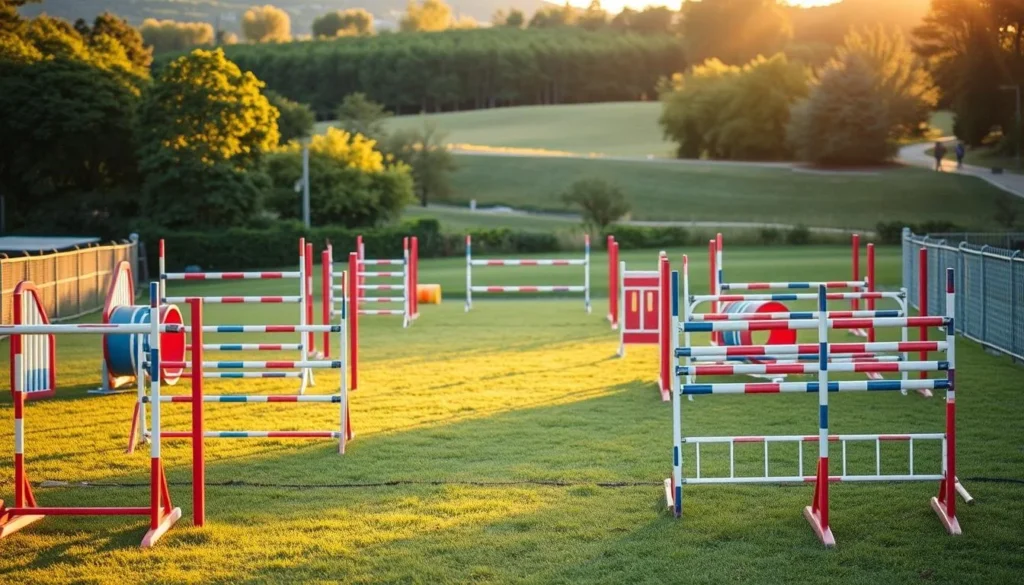
Safe introduction to jumps
I start with jumps that are very low. A broomstick on books or low jump cups is great for beginners. This low height reduces impact and helps dogs learn timing without getting tired.
Use lightweight poles that fall easily to prevent injury. Always train on non-slip surfaces and never push puppies to full competition height. As the dog gets stronger and more confident, you can raise the bar.
Building tunnel confidence
Start with short, see-through or partially covered tunnels. Sometimes, I use a blanket-draped chair or cardboard box as a mock tunnel. This makes the exit visible. A helper or toy at the far end acts as a lure and reward.
Keep the first runs short to avoid panic in dark spaces. Never force a dog into a tunnel. Once they're comfortable with short entries, you can make the tunnels longer and add gentle bends while keeping the training positive.
Approaches to weave pole training
Weaves can be challenging. I set poles about 24 inches apart when training outdoors, using tomato stakes or commercial poles. It's important to teach the dog to enter to the right of the first pole for reliable sequencing.
I use different methods like channel, 2-on/2-off, and guide-wire as needed. Then, I slowly fade the support. Many handlers find expert guidance or a focused class helps speed up progress and reduces frustration.
Below is a quick comparison to help plan practice sessions and choose dog agility training how to steps for each obstacle.
| Obstacle | Starting Setup | Session Focus | Progression |
|---|---|---|---|
| Jumps | Broomstick on books; low cups; non-slip surface | Form, takeoff timing, safe landings | Raise height gradually; add brief courses |
| Tunnels | Short see-through tunnel or blanket-over-chair mock tunnel | Exit visibility, positive association, short runs | Increase length and bends; remove visible cues slowly |
| Weave Poles | Tomato stakes or spaced poles 24" apart; channel or guides | Entry direction, sequencing, consistent repeats | Fade guides; increase speed and distance |
I mix these drills into a complete agility course for dogs. This tests their focus and handler communication. Regular, short sessions support steady progress in dog agility training without overloading the dog.
Conquering Contact Obstacles: A-Frame, Dog Walk, and Teeter
I teach contact obstacles with small, steady steps. This builds confidence and protects my dog's body. Sessions are short and positive. I use basics from dog agility training, add clear cues, and rely on safe equipment.
I start the A-frame with the ramp lowered for an easy angle. I use a single verbal cue like climb and a target pad or treat lid. This helps my dog touch the contact area consistently.
I vary entry and exit angles as training progresses. I add mild distractions and check for joint strain, especially in older dogs. Warm-ups and cool-downs are part of every session to reduce risk. I end on a win to keep my dog eager for the next session.
For the dog walk, I reinforce the contact zone with training hoops and targets. I reward precise foot placement. This makes the behavior automatic. I practice short, controlled sequences and lengthen them as confidence grows. Spotters help when I introduce higher heights or faster tempos.
I desensitize dogs to the teeter by starting on wobble boards, low-moving platforms, or a skateboard. I let the dog explore at its own pace, then encourage a single paw, then a full pass with slight pivoting. I use spotters and stepwise increases until the dog accepts the full teeter movement.
I watch fatigue closely and limit repetition because shoulders and hips take strain during contact work. My canine agility training plan spaces rest days and cross-trains for strength. When equipment wears or shifts, I replace or adjust it so it stays safe during practice.
Key drills I use:
- Short A-frame climbs with target pads and consistent cueing.
- Dog walk touch-and-reward runs, building length incrementally.
- Teeter desensitization using wobble boards, then low-angle pivots.
- Controlled entries and exits from different approaches.
Good progress relies on clear goals, reliable dog agility equipment, and a positive approach to canine agility training. I keep each session focused, fun, and injury-aware. This way, my partner learns to trust the obstacles and me.
Dog Agility Equipment: What to Buy and DIY Options
I choose gear that makes training fun and safe for both of us. A good starter kit includes competition-style jumps, an open tunnel, and weave poles. An A-frame or training frame and a low pause table are also key. Brands like Carlson Agility offer durable, competition-standard pieces and training-sized options for backyard practice.
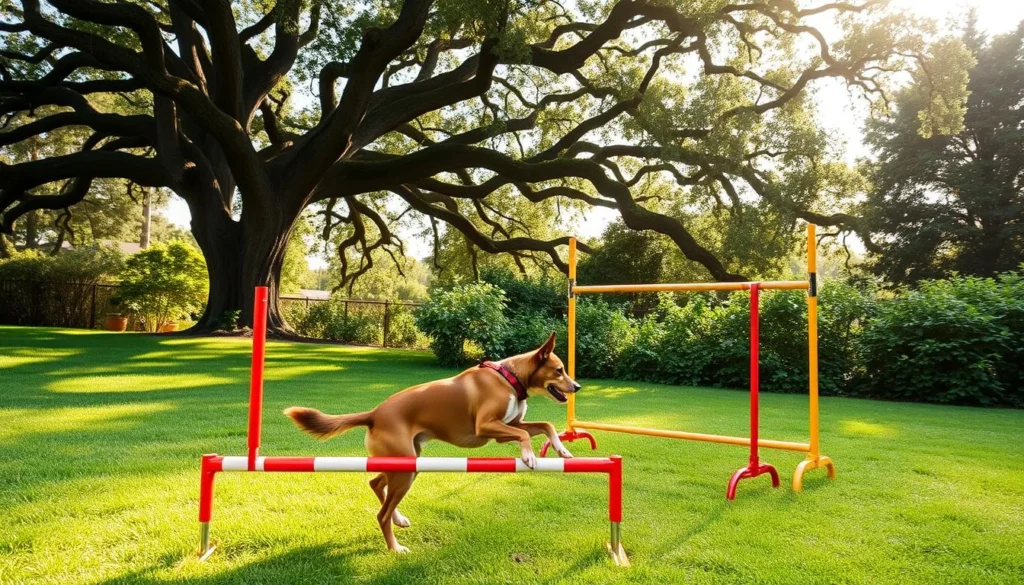
When setting up backyard agility, I focus on space, footing, and clear contact zones. Start with lowered or training-sized apparatus for beginners and small dogs. Use non-slip surfaces and check each piece for sharp edges before starting. Keep water and rest breaks ready during training.
My backyard gear recommendations:
- Adjustable bar jumps and lightweight stands for quick resets
- Open fabric tunnels that can curve for variety
- Weave poles in 6–12 sets with a stable base
- Training-sized A-frame and a dog walk with visible contact zones
- Low pause table and mini equipment for small breeds
DIY dog agility can save money and keep sessions fun. I've used broomsticks for low jumps and tomato stakes as weave poles. A blanket draped over chairs or cardboard boxes can make a short tunnel. An upside-down plastic bin works as a simple pause platform.
DIY builds need to be safe. Make sure homemade items are stable and slip-resistant. Use poles that fall when struck to avoid joint strain. Avoid high-impact equipment for growing puppies and test any DIY piece before letting a dog run full-speed.
I mix bought pieces with DIY aids for a balance of cost and longevity. I start with core commercial items for critical obstacles. Then, I fill practice drills with homemade tools. This keeps training varied and affordable while protecting my dog's joints and enthusiasm.
Handling Techniques and Course Strategy
I focus on precise handling techniques that let my dog move freely while I guide from a short distance. Good handling turns a busy agility course for dogs into a clear sequence. I build my plan around lines that keep pace steady and reduce wasted motion.
I practice a handful of basic moves until they become automatic. These moves help me send my dog out in front, switch sides smoothly, and create tight turns when needed. I use hand targets, treat placement, and my body position to shape the line I want.
Basic handling moves I practice
I work on sending out to a send-away marker so my dog learns to run ahead without me sprinting. This saves energy and sharpens timing in dog sports training.
I drill side switches while jogging to teach my dog to wrap around objects like cones and barrels. Figure-eight and circle exercises improve tight turning and body awareness.
I practice distance handling to move away from my dog and cue remotely. Distance skills mean handlers of varied fitness can still compete well in dog agility training.
Reading course maps and planning lines
I walk the course map and pick a few clean lines before the run. Planning means I can anticipate sequences, know when to delay, and choose moments to push speed or add control.
I volunteer at trials and do course walk-throughs to sharpen my reading skills. Observing other handlers helps me see alternate lines and refine my own strategy.
I map out where to use tight turns, where to send, and where to create distance. Those choices shape how efficiently my dog and I move through an agility course for dogs and raise our consistency in dog sports training.
Conditioning, Injury Prevention, and When to See a Vet
I make sure my dogs stay fit and healthy for our agility training. This keeps it fun and safe. I do warm-ups, conditioning, and simple checks before and after each session.
Physical conditioning and warm-ups
Every session starts with light cardio, like a brisk walk or jog. This gets their heart rate up and loosens muscles. Then, I do dynamic stretches to prepare their joints and prevent injuries.
I keep the obstacle work short, about 15–20 minutes. After intense work, I use gentle stretches and calm play to help them recover. For puppies, I use smaller jumps and training-sized equipment until they grow stronger.
Recognizing fatigue and signs of injury
Signs of fatigue include slower responses and heavy panting. I stop or switch to low-impact work if I see these signs. Proper conditioning helps, but I still watch closely.
Look out for limping, reluctance to jump, stiffness, swelling, heat, or changes in gait. These are signs of injury. I avoid steep A-frames with older dogs or those with joint issues to prevent extra strain.
Practical conditioning drills I use
- Core holds and side planks adapted for dogs to build trunk strength.
- Balance work on wobble boards to improve joint stability and proprioception.
- Controlled climbs and ladder walking to enhance paw placement and body awareness.
- Short play sprints for safe cardiovascular gains without long high-impact sessions.
When to seek professional help
If you notice limping, stiffness, swelling, or a change in gait, call the vet. Early attention can prevent chronic issues. If there's acute pain, lethargy, or trouble bearing weight, go to the clinic right away.
| Concern | Immediate Action | Training Adjustment |
|---|---|---|
| Minor stiffness after session | Rest, gentle massage, light stretching | Reduce intensity next session; add warm-up time |
| Reluctance to jump or climb | Short rest; observe for 24 hours | Lower jump heights; emphasize conditioning for dogs |
| Limping or favoring a leg | Contact vet; limit movement | Pause obstacle work; focus on low-impact rehabilitation |
| Swelling or hot joint | Seek vet immediately | Stop all high-impact activity until cleared |
| Sudden collapse or severe pain | Emergency vet visit | Follow veterinary recovery plan before resuming dog agility training |
Mental Training, Confidence Building, and Trial Preparation
I take small steps to build my dog's trust and focus. Short sessions and simple games make training fun. I celebrate each success to keep my dog excited for more.
I introduce mild distractions after my dog is confident on obstacles. I start with toys, crowd noise, and handler movement. This builds skills needed for dog agility and staying calm under pressure.
I practice mock trials to improve pacing and handling. I include distractions like people watching and other dogs. This rehearsal is crucial for a positive trial experience.
I volunteer at local events and attend AKC matches. Watching real trials helps me learn the flow. Agility Course Tests give us hands-on experience, making preparation less stressful.
I keep sessions upbeat and stop before my dog gets overwhelmed. If they seem worried, I go back to easier tasks. This patient approach protects their confidence and supports their success in agility and confidence training.
Conclusion
Dog agility training has changed nervous pets into confident athletes. It also strengthens the bond between handlers and dogs. Whether you're looking for fun at home or competition, agility training boosts fitness, focus, and teamwork.
Start slow and check with your vet before beginning. Use short, positive sessions to avoid injuries and burnout. This approach keeps training safe and enjoyable.
Safety and patience are key. I adjust equipment, break skills into steps, and reward success. Investing in good gear or DIY options and taking lessons with a certified instructor helps a lot. These steps make agility training fun and lasting.
Dog sports training is easy to find through local clubs, classes, and volunteer work. I use AKC programs to guide me and find places to watch trials. With consistent cues, gradual introductions, and a focus on fun, agility becomes a lifelong journey of learning and joy.

